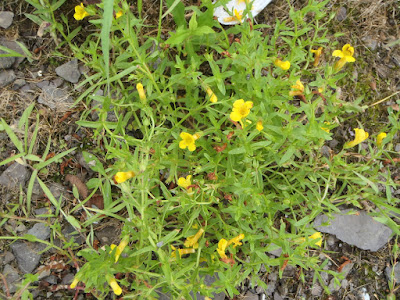This was our forth annual week at the AMC Ponkapoag camp, and our first time at a cabin within sight of the pond. While I was busy studying much of the time, I did walk a bit and got out on the pond a couple of times.

Golda, my assistant, eventually decided she'd seen everything.


"Island biogeography" this ain't: the fifty feet of shallow water
separating the island from the mainland is no barrier to plant or animal migration.
No one was more pleased to be back ashore than Golda.
She went directly to the door of the cabin. She was not entirely pleased with me.
Watching the sun set from my desk on the first full day.
If I have to be studying, at least I've got the best office!
If I have to be studying, at least I've got the best office!
A nice breeze off the pond for days meant no pages stayed on my desk
without rocks holding them down.
without rocks holding them down.
The pond, and an animal I didn't expect to see in it (northern water snake, I think).
Mid-week sunset over the pond.
Puppy belonging to the camp manager went after a stick floating in the water, and returned through white water lily pads (Nymphaea odorata) and tape grass (Valisneria americana).
One of the rare times my son was on the dock instead of in the water.
Nearly all the other kids were much younger, but he was a good sport.
Gypsy moths are another of the imported dangers to the forest.
Each of the brown egg masses on this trunk were laid by a female moth
that feasted as a caterpillar in the same tree. The eggs will hatch next spring.
I wrote about this situation three years ago:
"In an open woodland of oak and
pine, a dead tree leans on a live tree.
The two form with the ground an isosceles right triangle, the live tree
and the ground forming the right angle, the dead tree, fallen from twenty feet
away and landed neatly in a crotch of the living tree twenty feet up, the
hypotenuse. -or not really neatly, since the dead tree shed rotten branches
as it struck, which now form a sort of giant squirrel's nest where the two
trees come together.
"What happened here? The living tree is a black oak, tall and
straight with the high and narrow crown of a forest-grown tree, its only flaws
the vulnerable crotch, a small dead sprout at its base, and a small dead limb in its
crown. From its state of decay and that
of its branches, the other was long dead before its fall, so of unknown
species, and a little bigger than the one-foot diameter of the black
oak. Perhaps the dead tree got its start
a few years or a decade before the living, or perhaps the two were age mates,
even siblings, the dead tree's slightly greater and earlier girth the result of
a sunnier location, or a little more moisture.
What killed the one? Not age, but
some ill fortune--an infestation of caterpillars or a fungus borne by insects
burrowing into its wood, a drought. Perhaps it died
when struck by an earlier dead-fallen tree now long vanished into soil.
"How will events fall now? Certainly the dead tree has damaged the
slender forked oak, and that in a singular stroke of bad luck: the forking stems
so narrow that a matter of a few degrees either way in the fall would meant a
complete miss. Perhaps the falling tree
was so decayed that it did little damage.
Or perhaps even so the rotting wood provides habitat to a fungal or
insect invader. Moreover, yet another
dead tree, somewhat smaller, stands at a similar distance, and inclines a
little toward the burdened oak. Might
lightning strike twice? Indeed standing
dead trees are not uncommon in the wood.
Of course, the tall tree might equally benefit from the deaths of neighbors--if they stand southerly,
the openings they create allowing more sunlight to feed the tree. Every forest is indeed a slow race, with the
prize of vital sunlight to the tree that can keep its crown above its shading
neighbors. But the future is never secure,
and with the vagaries of chance even the most virtuous may succumb before their
time."
The wood is scattered with glacial erratics--boulders bulldozed into place by ice sheets
and left behind at the end of the last ice age. These boulders have had ten thousand years
or more to develop "character."
The less water-phobic of our two little dogs went paddling with me about midweek. (Actually, I did all the paddling.) A tiny island beckoned. Its size made possible a nearly-complete census of flowering plants in the space of a few minutes.
Goose poop is the foundation of the soil here.

Golda, my assistant, eventually decided she'd seen everything.


"Island biogeography" this ain't: the fifty feet of shallow water
separating the island from the mainland is no barrier to plant or animal migration.
No one was more pleased to be back ashore than Golda.
She went directly to the door of the cabin. She was not entirely pleased with me.

































No comments:
Post a Comment